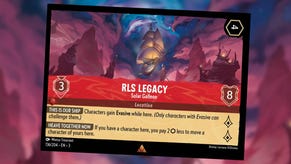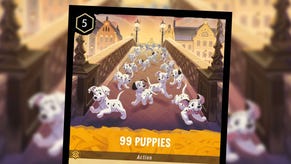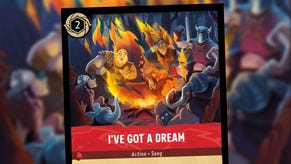Disney Lorcana's leaked rules show a trading card game eager to be slightly different from its peers
A tap by any other name turns just as sideways.
The rules for Disney Lorcana leaked online yesterday, providing players their best look yet at the mechanics for pitting Micky, Elsa and other popular animated characters against each other. It shows both clear inspirations and novel diversions from other well known trading card games in its design.
Screenshots from the May edition of Game Trader Magazine, an industry publication largely meant for retailers, appeared online ahead of Lorcana’s planned public unveiling at this year’s Gen Con. Shortly after, publisher Ravensburger reportedly released a more comprehensive breakdown on the TCG’s official website, including deckbuilding tips and a multiplayer variant.
Players, called Illumineers in Lorcana’s parlance, will spend a match attempting to be the first to collect 20 Lore by casting character, items and actions, called Glimmers, from their hand in order to overcome quests and challenges. Summoning Glimmers requires a certain ink cost from a player’s well, which they fill by placing one card with the appropriate circle around its normal cost, facedown in the well. Think of it like Magic: The Gathering’s lands - if there are four facedown ink cards, a player may spend a grand total of four ink across all other cards played that turn.
Certain character Glimmers will have a specific number of diamond-shaped lore symbols on the right side of their rule box, which indicates how much Lore is gained when they go on a quest - one of the two core actions in Lorcana. Players “exhaust” Glimmers to send them questing for Lore, turning them sideways in a motion that is definitely not tapping but looks practically identical. Questing Glimmers leave themselves open to challenges from the opposing player on their own turn, but those vengeful characters must exhaust, as well, forcing both sides to gamble with precious pieces.
During challenges, character Glimmers use the Strength and Willpower statistics on their cards to determine the results. Strength values are subtracted from Willpower by placing damage counters on the card, and if that latter stat ever reaches zero the Glimmer is Banished - removed from play for the rest of the game. Damage dealt to cards doesn’t wear off at the end of the turn, so every exhaustion will likely bring any Glimmers involved closer to the end of their tenure on the board.
We also know that ink can be spent to play items, cards which stay on the board and introduce new activated effects, and actions - this latter card is a one time use spell that seems powerful and costly in a game largely built around keeping things in play for as long as possible. One other card type, Songs, have at least two variable costs in ink or exhausted characters, showing that there’s still a strategic depth to Lorcana not yet fully explored in the leaked material.

Beyond exhausting (the litigiously impregnable tapping alternative), the design shadow of MTG looms fairly large in Lorcana’s broad design. Glimmers can’t take any actions on the turn they’re played (aka summoning sickness) and players’ turns are split into its own ‘untap, upkeep, draw’ mnemonic for cleaning up and preparing for the main phase: ‘ready, set, draw’ returns all exhausted cards to their upright position, handles any start-of-turn effects and lets players draw one card from the top of their deck.
Deckbuilding, too, follows close to Richard Garfield’s most popular creation. Player decks must contain at least 60 cards (for standard play, at least), but only four of each character, item, action, etc. can be included. Interestingly, the basic rules demand that decks can’t contain more than two of the five Ink Colours - Amber, Emerald, Ruby, Sapphire, Amethyst and Steel.
Lorcana’s most interesting parts are the areas in which it strays away from MTG’s dominant model. No combat phase represents a massive shrinking of the potential design and interaction space, but that could be largely compensated by exhaustion’s seemingly broad application. Regardless, it will be interesting to see how a trading card game that imagines a slightly different approach to competitive matches fares amidst a well-established genre. Lorcana’s The First Chapter set is due for public release on August 18th in hobby shops and September 1st everywhere else.








